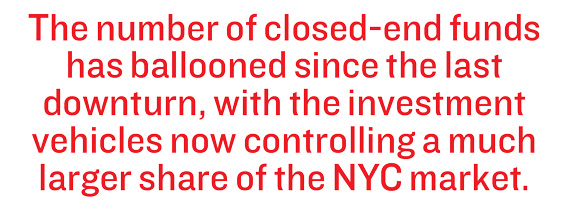Trending
The ‘closed’ fund conundrum
Blackstone deal shines light on ‘closed-end funds,’ but as market shift looms these investment vehicles could face new pressure

When news broke earlier this summer that the Blackstone Group [TRDataCustom] was planning to take its rental-home company, Invitation Homes, public by the first half of 2017, it came as little surprise.
The private equity giant bought up 50,000 rental homes nationwide in the aftermath of the most recent financial crisis, with the intention of flipping them for a profit — either by selling them individually, unloading them in bulk or taking the portfolio public.
It didn’t have a choice, since the fund that bought the homes — Blackstone Real Estate Partners VII — has a contractual obligation to sell its properties and return its investors’ money within a decade.
But the deal did shine a light on so-called “closed-end” funds, which have a fixed life span and don’t sell new shares once an initial fund-raising period is over. These funds played a big role in helping the New York real estate market recover from its 2009 slump by buying up office and retail properties and bankrolling many of the latest condo towers.
Fund manager CIM Group, for example, has financed condo developments such as Macklowe Properties’ 432 Park Avenue and 737 Park Avenue, as well as HFZ Capital Group’s One Madison and Ben Shaoul’s 140 West Street. Meanwhile, closed funds run by Beacon Capital Partners scooped up office buildings such as 195, 222 and 1633 Broadway, all properties it has since sold off.
While these investment vehicles have ballooned since the last downturn and now control a much larger share of the New York real estate market than they did in the past, many will have to return money to investors in the next few years. And if a downturn hits during that time — as some economist believe it will (see related story on page 38) — these funds could face pressure to sell at bargain prices.
Over the past few years, closed funds have returned far more money to existing investors than they’ve called up from new ones — a major about-face from the decade between 2002 and 2012, according to New York-based research firm Preqin.
In 2015, for example, they distributed $194 billion to investors and took in only $94 billion.
These funds have become incredibly popular with investors, who are guaranteed to get their money back in eight to 10 years and can expect double-digit annual returns — if things go right. But they also come with a big challenge: deadlines for selling their properties.

432 Park Avenue
That can be a tricky proposition in the inherently cyclical real estate business.
“There’s not a true gun to most people’s heads, but essentially the manager is under pressure to sell,” said one executive at a major fund manager who asked to remain anonymous.
And the industry seems to be closely watching these funds to see how they proceed in this uncertain market.
Andrew Moylan, Preqin’s head of real estate asset products, said that many of these funds are reaching maturity in the near future.
“It could be very interesting to see what happens in the next couple of years,” he said.
Inner workings
While most in the industry know that these funds have been actively snapping up properties, understanding how they work is key to predicting their next moves.
For starters, most closed-end funds span three time periods: a three- to five-year investment push; a roughly five-year “harvesting” period, during which time the assets are either flipped for a quick profit or held and given a chance to ripen; and a one- to two-year wind-down when the fund sells any remaining assets.
Although these funds have sell deadlines that don’t exist for many other investment vehicles, most fund managers today include clauses in their contracts with investors that allow them to hold onto an asset for longer if the market isn’t strong enough for a sale. (And often they are able to exceed even those extensions if they can convince investors that waiting will pay off.)
“My impression is that by and large investors don’t want forced sales,” said Preqin’s Moylan.
But Michael Wolitzer, an attorney at Simpson Thacher & Bartlett who specializes in working with private fund managers, said those delays often come with financial strings attached for the funds.
“Sometimes when people seek extensions, limited partners say, ‘OK, we’ll give you another year or two, but we don’t want you to charge management fees anymore,’ ” he said. (Fees, which tend to be around 1.5 percent to 2 percent of invested capital, are one way managers make money — along with carried interest and other incentive structures.)
But downturns can pose problems for funds. Investors are more apt to need their money back and more likely to lose faith in their managers, all of which put more pressure on funds to sell.
During the most recent financial crisis, for example, some asset owners got hit with losses when “fellow investors had liquidity challenges that led them to sell their stakes in a fund or seek redemptions,” according to a 2014 report from the World Economic Forum.
In addition, if the lending markets weaken, closed-end funds — which are often highly leveraged and dependent on refinancing deals — may be forced to sell properties even if their equity investors are willing to wait, because their debt gets too expensive.
This was exactly what happened during the last downturn.
“In a big downturn, long before you get to end-of-fund-life issues, you get to end-of-deal issues,” Wolitzer said.
 One of the funds that fell victim to the last cycle was the Manhattan-based hedge fund manager D.E. Shaw, which invested around $2 billion in real estate nationwide before the market collapsed. It financed a giant New Mexico land acquisition with risky short-term debt. But in 2010, the lender foreclosed and D.E. Shaw and its partner filed for bankruptcy, forcing it to sell. Around the same time, in April 2010, it sold a 49 percent stake in the office building 340 Madison Avenue to RXR Realty for about $280 million and made a profit, according to the Wall Street Journal. While it’s unclear if that was a forced sale, it came just before it had a $400 million mortgage maturing in 2011.
One of the funds that fell victim to the last cycle was the Manhattan-based hedge fund manager D.E. Shaw, which invested around $2 billion in real estate nationwide before the market collapsed. It financed a giant New Mexico land acquisition with risky short-term debt. But in 2010, the lender foreclosed and D.E. Shaw and its partner filed for bankruptcy, forcing it to sell. Around the same time, in April 2010, it sold a 49 percent stake in the office building 340 Madison Avenue to RXR Realty for about $280 million and made a profit, according to the Wall Street Journal. While it’s unclear if that was a forced sale, it came just before it had a $400 million mortgage maturing in 2011.
Meanwhile, fund managers Aberdeen Property Investors and Schroders faced a similar dilemma in 2010 over its 1.1-million-square-foot London office development Chiswick Park, which was owned by a joint fund. The project was still under construction, but the fund had expired in late 2009 and its investors refused to agree to an extension, the Financial Times reported at the time. So the firm had no choice but to sell at a discount, with Blackstone picking it up for roughly $745 million in January 2011, according to news reports. Almost exactly three years later, Blackstone sold the property to China Investment Corporation for $1.28 billion.
If these past examples are any indication, a downturn here could put increased pressure on fund managers to sell assets in New York and elsewhere. That, in turn, could mean a drop in prices.
The next chapter
Simpson Thacher’s Wolitzer said he believes that a market drop could lead to more “synthetic secondaries,” which are essentially new funds created out of old ones. The practice is already prevalent in the private equity world.
Here’s how it works: If some fund investors want their money back at the end of its term but others are fine with a little delay, the fund manager can pay off those who want to get out and create a new fund for those who want to “ride, ride,” Wolitzer said.
At the same time, industry observers pointed to the growing number of “open-ended” real estate funds. Those funds don’t have fixed expiration dates and allow for more long-term investments.
Byron Carlock, who heads PricewaterhouseCoopers’ U.S. real estate practice, said, in general, fund investors are less insistent on getting their money back these days, because finding new assets to invest in is not easy. That’s largely because of the record-low interest rates and an oversupply of capital chasing opportunities in today’s slow-growth economy.
That’s a marked difference from the early 1990s, when private funds first popped up and were buying and selling properties in an environment of strong economic growth and relatively high interest rates.
Many firms — like Blackstone — run both closed and open funds. For it’s part, the firm has been growing its open-ended real estate fund, Blackstone Property Partners International.
In doing so, it’s making good on a promise made by CEO Stephen Schwarzman — who said in 2014 that the firm’s core real estate business could top $100 billion in a decade.
“I have extremely ambitious objectives for this area,” he said during an earnings call earlier this year. As of April 2016, Blackstone Property Partners International stood at $12 billion in equity.
In 2015, Blackstone used the open fund to buy Stuyvesant Town-Peter Cooper Village for $5.3 billion, in partnership with investment manager Ivanhoé Cambridge. The head of Blackstone’s real estate division, Jonathan Gray, said last October that it bought the property with money from investors who “wanted us to use less debt on the property, take less risk and have much longer hold periods.”
But open-ended funds can also face challenges because investors often have more freedom to withdraw capital. Following Britain’s vote to leave the European Union, in late June, several major British open-ended real estate funds froze withdrawals because they didn’t have enough money to immediately repay investors.
In the end, Pricewaterhouse-Coopers’ Carlock said, both closed-end and open-ended funds will continue to
appeal to different investors. “There’s a fund for every appetite,” he said.




